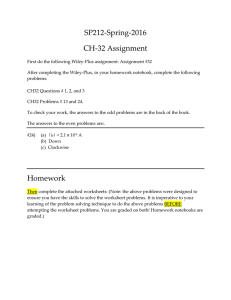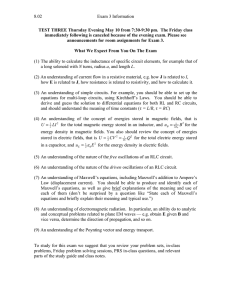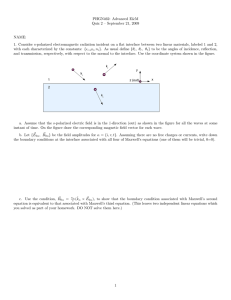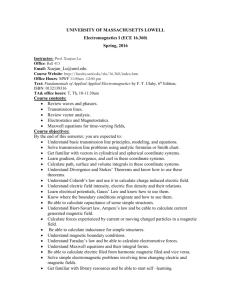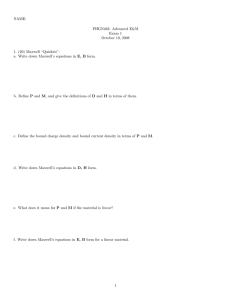Module I: Electromagnetic waves - Lecture 1: Maxwell`s equations: a
advertisement
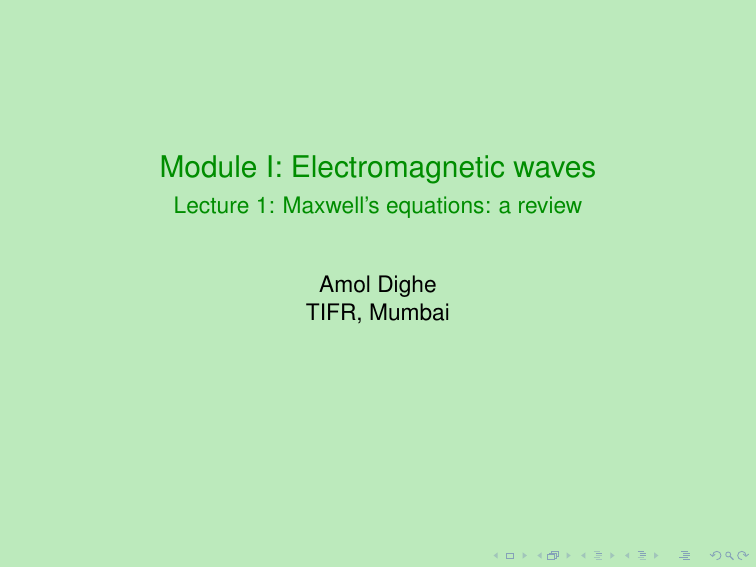
Module I: Electromagnetic waves Lecture 1: Maxwell’s equations: a review Amol Dighe TIFR, Mumbai Outline 1 Maxwell’s equations in vacuum 2 Maxwell’s equations inside matter Coming up... 1 Maxwell’s equations in vacuum 2 Maxwell’s equations inside matter In the language of differential vector calculus Gauss’s law: ~ = ρ ∇·E 0 (1) Gauss’s law for magnetism: ~ =0 ∇·B (2) ~ ~ = − ∂B ∇×E ∂t (3) Maxwell-Faraday equation Ampere’s law, with Maxwell’s correction ~ = µ0 ∇×B ~ ~J + 0 ∂ E ∂t ! We shall now look at interpretations of these expressions by using their integral forms. (4) Gauss’s law: enclosed charges ~ = ρ/0 : ∇·E Integrate over a closed volume: Z Z ~ (∇ · E)dV = V V ρ dV 0 Use a mathematical identity (Gauss’s theorem) I ~ = Qenclosed ~ · dS E 0 (5) (6) Relationship between electric field on a closed surface and the charge enclosed inside it The part in red: source of the electric field ~ Leads to Coulomb’s law if Q is a point charge at the centre of S, a sphere of radius r : Er · 4πr 2 = Q/0 Gauss’s law: no magnetic monopoles ~ =0: ∇·B Integrate over a closed volume: Z ~ (∇ · B)dV =0 (7) V Use a mathematical identity (Gauss’s theorem) I ~ =0 ~ · dS B (8) Relationship between magnetic field on a closed surface and the magnetic charge enclosed inside it The part in red: source of the magnetic field. Vanishing of the source ⇒ no magnetic monopoles Maxwell-Faraday equation: flux through a loop ~ = −∂ B/∂t ~ ∇×E : Integrate over a surface whose boundary is a loop: Z Z ~ ~ ~ ~ (∇ × E) · d S = −(∂ B/∂t) · dS ~ S (9) ~ S Use a mathematical identity (Stokes’ theorem) I Z ∂ ~ ~ ~ · d ~` = − E (B.d S) ~ S ∂t (10) (If the loop does not change with time) The induced EMF is I Z ~ = − ∂Φ ~ · d ~` = − ∂ ~ S) E≡ E (B.d ∂t ~S ∂t (11) Φ≡ R ~ S ~ ~ S B.d More comments on the Maxwell-Faraday equation Relationship between electric field along a loop and the rate of change of magnetic flux through an open surface whose boundary is the loop ~ and B ~ No sources needed: it is a relationship between E The “E = −∂Φ/∂t” equation does not hold for all situations, since it does not take into account the Lorentz force on a moving charge in a magnetic field. For example, see the discussion about Faraday Wheel in Feynman lectures. We’ll return to this point later in the course. Ampere’s law with Maxwell’s corrections ~ = µ0 (~J + 0 ∂ E/∂t) ~ ∇×B : Integrate over a surface whose boundary is a loop: Z Z Z ~ = µ0 ~J · d S ~ + µ0 0 (∂ E/∂t) ~ ~ · dS ~ (∇ × B) · dS ~ S ~ S (12) ~ S Use a mathematical identity (Stokes’ theorem) I Z ∂ ~ ~ ~ ~ B · d ` = µ0 I + µ0 0 (E.d S) ∂t ~ S (13) Relationship between magnetic field along a loop and the rate of change of magnetic flux through an open surface whose boundary is the loop H ~ is the conduction current I = ~S ~J · d S R ∂ ~ is often called “displacement current”, this is the ~ S) µ0 ~S ∂t (E.d correction by Maxwell to Ampere’s law Coming up... 1 Maxwell’s equations in vacuum 2 Maxwell’s equations inside matter Inside a dielectric medium (static case) ~ = ρ/0 Gauss’s law always valid, when ρ is the total charge: ∇ · E Part of the charge is due to polarization induced in the medium, which gives rise to the “bound charge”: ~ where P ~ is the polarization ρb = −∇ · P, ~ = (ρb + ρfr ) = −∇ · P + ρfr , Then 0 ∇ · E where ρfr is the free charge density ~ = 0 E ~ + P, ~ we get Gauss’s law in terms of the free Defining D charge density: ~ = ρfr ∇·D (14) ~ = E ~ defines the dielectric permittivity of the The relation D medium, . This is in general not a number but a tensor, and may not be constant. Wherever it is constant, the dielectric is called “linear”. Inside a magnetic medium (static case) Maxwell-Faraday equation always valid, when ~J is the total ~ = µ0~J current: ∇ × B Part of the current is due to magnetization induced in the medium, which gives rise to the “surface current”: ~Jsurface = ∇ × M, ~ where M ~ is the magnetization ~ = (~Jsurface + ~Jfr ) = µ0 ∇ × M + µ0~Jfr , Then ∇ × B ~ where Jfr is the free current density ~ = B/µ ~ 0 − M, ~ we get Ampere’s law in terms of the free Defining H charge density: ~ = ~Jfr ∇×H (15) ~ = µH ~ defines the magnetic permeability of the The relation B medium, µ. This is in general not a number but a tensor, and may not be constant. Wherever it is constant, the magnetic medium is called “linear”. Maxwell’s equations: “macroscopic” form ~ = ∇·D ~ = ∇·B ρfr (16) 0 (17) ~ = ∇×E − ~ ∂B ∂t ~ ~ = ~Jfr + ∂ D ∇×B ∂t (18) (19) These are equivalent to the equations (1)–(4), with the substitutions ρ = ρfr + ρb , ~J = ~Jfr + ~Jsurface (20) ~ = 0 E ~ +P ~ , D ~ = µ0 (H ~ + M) ~ B (21) ~ , ρb = −∇ · P ~ ~Jsurface = ∇ × M ~ + ∂D . ∂t (22) Recap of topics covered in this lecture Maxwell’s equations: in differential and integral form Maxwell’s equations in the presence of dielectrics and magnetic media
